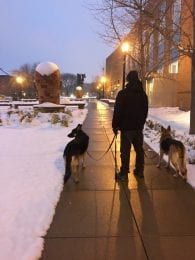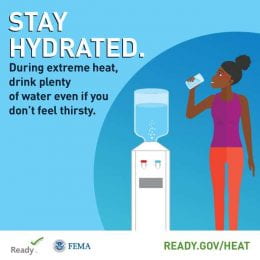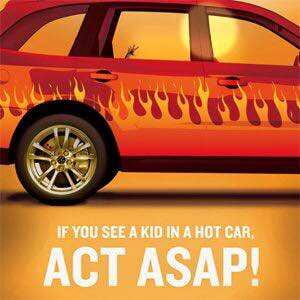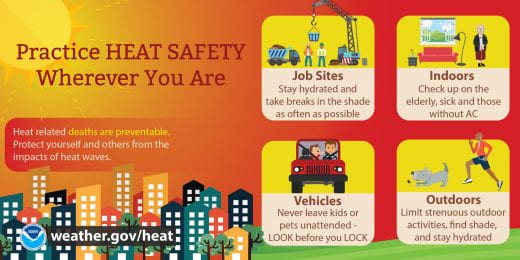 Pets need protection from cold too! Keep them safe before, during, and after winter storms and extreme cold. K-State veterinarian shares #WinterSafety tips to help pets cope.
Pets need protection from cold too! Keep them safe before, during, and after winter storms and extreme cold. K-State veterinarian shares #WinterSafety tips to help pets cope.
Tag: temperature extremes
 Heat waves are prolonged periods of excessive heat, often with excessive humidity: https://www.weather.gov/safety/heat
Heat waves are prolonged periods of excessive heat, often with excessive humidity: https://www.weather.gov/safety/heat
Extreme heat makes the body work extra hard to maintain a normal temperature. Stay indoors as much as possible and limit exposure to the sun. Dress in loose-fitting, lightweight, and light-colored clothes. Avoid dark colors because they absorb the sun’s rays. Drink plenty of water, even if you don’t feel thirsty.
Check on family, friends, and neighbors who do not have air conditioning and who spend much of their time alone. Don’t forget about your pets. Share these tips from the Humane Society to keep pets safe in the heat: http://bit.ly/1RRltIL
Listen to local weather forecasts to prepare for extreme heat. Be prepared.
#BeatTheHeat
#KeepYourCool — Practice #HeatSafety
Heat is one of the leading causes of weather-related fatalities each year. Heat waves have the potential to cover a large area, exposing a high number of people to a hazardous combination of heat and humidity, which can be very taxing on the body. Learn how to stay safe during a heat wave at www.weather.gov/heat
Know the Terms (from https://www.weather.gov/safety/heat-ww)
- Excessive Heat Warning—Take Action! An Excessive Heat Warning is issued within 12 hours of the onset of extremely dangerous heat conditions. The general rule of thumb for this Warning is when the maximum heat index temperature is expected to be 105° or higher for at least 2 days and night time air temperatures will not drop below 75°; however, these criteria vary across the country, especially for areas not used to extreme heat conditions. If you don’t take precautions immediately when conditions are extreme, you may become seriously ill or even die.
- Excessive Heat Watches—Be Prepared! Heat watches are issued when conditions are favorable for an excessive heat event in the next 24 to 72 hours. A Watch is used when the risk of a heat wave has increased but its occurrence and timing is still uncertain.
- Heat Advisory—Take Action! A Heat Advisory is issued within 12 hours of the onset of extremely dangerous heat conditions. The general rule of thumb for this Advisory is when the maximum heat index temperature is expected to be 100° or higher for at least 2 days, and night time air temperatures will not drop below 75°; however, these criteria vary across the country, especially for areas that are not used to dangerous heat conditions. Take precautions to avoid heat illness. If you don’t take precautions, you may become seriously ill or even die.
- Excessive Heat Outlooks are issued when the potential exists for an excessive heat event in the next 3-7 days. An Outlook provides information to those who need considerable lead-time to prepare for the event.

